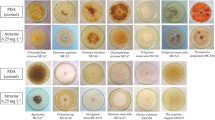Abstract
When incubated in synthetic (N-limited) medium and on ashwood chips, Phanerochaete chrysosporium BKM-F-1767 degraded 14 and 10 mg/l diuron, respectively. The wood chips were used as support and sole nutrient source for the fungus. A higher degradation efficiency was found in ashwood culture as compared to the liquid culture, probably as a result of the synergetic effect of attached fungal growth, presence of limiting-substrate conditions and the microenvironment provided by ashwood, all favorable for production of high extracellular enzyme titres. Diuron degradation occured during the idiophasic growth, in the presence of manganese peroxidase, detected as dominant enzyme in both cultures.
Similar content being viewed by others
References
Armenante PM, Pal N, Lewandowski G (1994) Appl. Environ. Microbiol. 60: 1711–1718.
Barr DP, Aust SD (1994) Env. Sci. Technol. 28: 79A-87A.
Bumpus JA, Tien M, Wright D, Aust SD (1985) Science 228: 1434–1436.
Bumpus JA, Aust SD (1987) BioEssays 6: 166–170.
de Jong E, Field JA, de Bont JAM (1994) FEMS Microbiol. Rev. 13: 153–188.
Ellis PA, Camper ND (1982) J. Environ. Sci. Health B17: 277–289.
Esposito E, Paulillo SM, Manfio GP (1998) Chemosphere 37: 541–548.
Field JA, de Jong E, Feijoo-Costa G, de Bont JAM (1993) TIBTECH 11: 44–48.
Gold MH, Glenn JK (1988) Methods Enzymol. 161: 258–264.
Hammel KE (1989) Enzyme Microb. Technol. 1: 776–777.
Hofrichter M, Scheibner K, Scheneegaß I, Fritsche W (1998) Appl. Environ. Microbiol. 64: 399–404.
Howard PH (1991) Handbook of Environmental Fate and Exposure Data for Organic Chemicals. Lewis Publishers, Inc., pp. 319–326.
Harazano K, Kondo R, Sakai K (1996) Appl. Environ. Microbiol. 62: 913–917.
Huijser PJ (1994) Verontreiniging van de Maas door Diuron. RIZA, Nota nr.: 94.014, pp. 10–16.
Huijser PJ (1996) Verontreiniging van de Maas en Zijrivieren in 1994 en 1995 door Diuron. RIZA, Nota nr.: 96.018, pp. 40–41.
Jensen KA Jr, Bao W, Kawai S, Srebotnik E, Hammel KE (1996) Appl. Environ. Microbiol. 62: 3679–3686.
Kirk TK, Schultz E, Connors WJ, Lorenz LF, Zeikus JG (1978) Arch. Microbiol. 117: 277–285.
Kirk TK, Lamar RT, Glaser JA (1992) The potential of white-rot fungi in bioremediation. In: Mongkolsuk S, Lovett PS, Trempy JE, eds. Biotechnology and Environmental Science: Molecular Approaches. New York: Plenum Press, pp. 131–138.
Lewandowski GA, Armenante PM, Pak D (1990) Wat. Res. 24: 75–82.
Madhun YA, Freed VH (1987) Chemosphere 16: 1003–1011.
Mester T, de Jong E, Field JA (1995) Appl. Environ. Microbiol. 61: 1881–1887.
Mester T, Swarts HJ, Romero i Sole S, de Bont JAM, Field JA (1997) Appl. Environ. Microbiol. 63: 1987–1994.
Orth AB, Royse DJ, Tien, M (1993) Appl. Environ. Microbiol. 59: 4017–4023.
Paice MG, Reid ID, Bourbonnais R, Archibald FS, Jurasek L (1993) Appl. Environ. Microbiol. 59: 260–265.
Pal N, Lewandoski G, Armemante PM (1995a) Biotechnol. Bioengg. 46: 599–609.
Pal N, Chritodoulatos C, Kodali S (1995b) Proc. 27th Ind. Waste Conf.: 284–293.
Paszczynski A, Crawford RL (1995) Biotechnol. Prog. 11: 368–379.
Rayner ADM, Boddy L (1988) Fungal Decomposition of Wood. Its Biology and Ecology. New York: Wiley-Interscience, pp. 14–58.
Sayadi S, Zorgani F, Ellouz R (1996) Role of lignin peroxidase and manganese peroxidase of Phanerochaete chrysosporium in the decolorization of olive mill wastewaters. In: Moo-Young M, Anderson WA, Chakrabarty AM, eds. Environmental Biotechnology: Principles and Applications. Dordrecht: Kluwer Academic Publishers, pp. 511–523.
Tien M, Kirk TK (1988) Methods Enzymol. 161: 238–249.
Tillmanns GM, Wallnofer PR, Engelhardt G, Olie K, Hutzinger O (1978) Chemosphere 1: 59–64.
Vares T, Lundell TK, Hatakka AI (1992) FEMS Microbiol. Lett. 99: 53–58.
Vares T, Kalsi M, Hatakka A (1995) Appl. Environ. Microbiol. 61: 3515–3520.
Venkatadri R, Irvine RL (1993) Wat. Res. 27: 591–596.
Vroumsia T, Steiman R, Seigle-Murandi F, Benoit-Guyod J-L, Khadrani A (1996) Chemosphere 33: 2045–2056.
Weinberger M, Bollag J-M (1972) Appl. Microbiol. 24: 750–754.
Yum K-J, Peirce JJ (1998a) J. Env. Engg. 124: 184–190.
Yum K-J, Peirce JJ (1998b) Water Env. Res. 70: 205–213.
Author information
Authors and Affiliations
Rights and permissions
About this article
Cite this article
Fratila-Apachitei, L.E., Hirst, J.A., Siebel, M.A. et al. Diuron degradation by Phanerochaete chrysosporium BKM- F-1767 in synthetic and natural media. Biotechnology Letters 21, 147–154 (1999). https://doi.org/10.1023/A:1005476018325
Issue Date:
DOI: https://doi.org/10.1023/A:1005476018325




